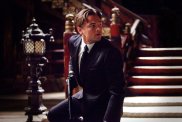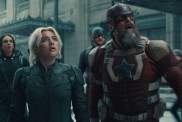Writer cuts his teeth in the director’s chair

A poster for Tobe Hooper’s Crocodile hangs framed in this L.A.-based guest house-cum-office where writer-director Adam Gierasch works. Even if it’s not the most inspired piece of artwork (a reptilian eye staring out from the dark), the one-sheet is rare. One of only a few made. It dwarfs some of the other promo pieces adorning the walls here. Neatly lined up above Gierasch’s computer: Sales art for other films he’s penned with partner Jace Anderson. Crocodile 2 (“Death Swamp,” bitches!). Another Hooper effort (arguably his best in some time) The Toolbox Murders. Dario Argento’s Mother of Tears. Rats. Well, that last one Gierasch acted in, just one of a few films he’s appeared in (you’ll see him next in the February DVD release Red Sands). These posters are all reminders of where Gierasch and Anderson have come from and the growth they’ve shared creatively and commercially.
Writer. Director. Gierasch has even done a bit of producing (he was given associate producer cred on Toolbox). And now this multi-hyphenate is adding “director” to his resume. Next month sees the release of his feature debut Autopsy, a depraved and fantastically gross horror film starring Jessica Lowndes (90210), genre vets Robert Patrick and Jenette Goldstein, Michael Bowen (The Lost) and Robert LaSardo (Tyrese’s road kill in Death Race). A confidently-directed, bizarre throwback to the “anything goes” mentality of ’80s horror (in this writer’s mind, at least), Autopsy – the story of a group of Mardi Gras party-goers who are trapped in a hospital with a wicked staff – is a participant in After Dark Films’ Horrorfest III (opening January 9th).
In post-production on his sophomore directing effort, a remake of Night of the Demons (exclusive set report), Gierasch invited ShockTillYouDrop.com over recently to reminisce about his time on Autopsy (which lensed in early 2007), its Italian influences and real-life inspirations.
ShockTillYouDrop.com: After all of this time writing for various directors, how did you choose Autopsy to be your directorial debut?
Adam Gierasch: Evan Katz and I decided we were going to write a script together just a.) for fun and b.) because it would help get Evan started in the business. Evan originally had this idea of a bunch of punk rock squatters getting attacked in Hollywood. I didn’t know how to make that movie, but we decided to do a hospital horror movie. So, we wrote Autopsy together with Jace [Anderson], of course. It was one of these scripts people liked right away and it got optioned right away. Then the option expired and, at the time, it was a ghost story. A supernatural haunted hospital movie. I wasn’t interested in ghosts and we decided to take them out and set the story in the real world. We finished a new draft and there were two potential options and we chose to go with producer Warren Zide.
Shock: And he was coming off of Final Destination. What was it about the script that he liked?
Gierasch: He was looking for a commercial property that was something cool but different than what he had seen recently. This seemed catchy to him.
Shock: Was there any other interest from other directors to come on board?
Gierasch: No, we optioned it with the sole purpose of me directing. We had worked with enough famous horror directors and had so much fun doing it. After we got the job for Mother of Tears and Dario Argento and Claudio flew us out to Italy, that was like we had reached the mountain top. Now it’s time to start thinking about making our own movies.

Shock: Did any of it stem out of your frustration of seeing your scripts possibly tampered with? A want for more control?
Gierasch: No, not at all. As screenwriters we’re pretty good about trying to do the best job we can and yet remain detached in a sense. It’s very important. In my opinion, the screenwriting is the most important thing. Nothing really comes close. Casting would be second on the list. We just wanted to try it out. I was getting jealous watching other people direct. I could do this, I thought. I have in my head how to do this. I was a drama major in college. I had directed plays out here. I did performance art pieces and now it was time for me to do it. It felt very natural.
Shock: You just placed emphasis on casting, so how did that process go for you?
Gierasch: It was great. A woman named Melissa Skoff did the casting. We had no set parameters and we had all of these fresh faces coming in for the kids. I thought they were all fantastic. It was not a hair-wrenching process in the slightest. Jessica [Lowndes] came in direct from Canada, and she was young, enthusiastic, naive. Still knew enough that she would want to do fight scenes without stunt people and stuff like that. That goes away after a while. [laughs] Everybody was just enthused to be in the movie.
The older character actors we cast a bit differently. I was watching TV one night and I saw Robert LaSardo on Nip/Tuck and just thought, damn, I like that guy. I went in the next day and asked Melissa to call in LaSardo for me. She called him in, we read him and he got the part. Michael Bowen I had remembered seeing him in Kill Bill. It wasn’t the most imaginative casting on my part, because he was an evil orderly in that movie and he could be an evil orderly for me. My guy’s even sicker. And he’s fantastic and one of the best actors I’ve worked with period. I can’t say enough good things about him. I met with Robert Patrick and he was great. And Jenette Goldstein, I found her picture on a pile of headshots. I was like, holy crap, it’s Vasquez [from Aliens]! She’d make a wonderful nurse.
Shock: Did the actors bring any shades to their characters you didn’t see before?
Gierasch: I talked to them about it a lot. For Jenette, we didn’t want her to be Nurse Ratched. That was her big goal. She came up with some great ideas. It was her idea to give her character the cleanliness fetish she has. You always see her wiping the phone and when she gets bloody… Getting dirty doesn’t work for her very well. [laughs] Robert Patrick, one of the things we wanted was the aesthetics of the hospital to be very Third Reich. I wanted it to look Nazi-ish. I pictured Robert Patrick as a throwback to an old Nazi doctor. I wanted everybody to look very out of time. Not current, not old. Just from another time. So, Robert had some really great ideas about being extremely formal, rigid, he wanted his hair parted on the side. He wore the glasses. Like I said, all of the casting stuff was fantastic. And on a horror movie like this, you don’t have a lot of time to learn about the characters, they’re just running around the hospital so these people needed to bring it with them.
Shock: Where did you find your hospital location?
Gierasch: We shot it in a little town called Jacksonville, Louisiana. It was about forty-five minutes north of Baton Rouge and a working mental hospital. A place where they put people that have been found not guilty by reason of insanity.
Shock: Fully-functioning hospital?
Gierasch: Fully functioning. [laughs] All of the dangerous patients…we weren’t allowed to call them patients while we were there, they were called “clients” – we were not allowed to interact with the clients and truth be told, the dangerous ones were locked up in a separate building. The building we shot it in was still used, they cleared people out and we did a little construction work to make it look like it had long corridors, which there weren’t in real life. It was a pretty mellow place to shoot. Very quiet and we had free run of the grounds. The clients were, let’s put it this way, in their rooms. But they did get to decorate the outside of the hospital for us.

They loved it. In fact, we tried to use as many of them in the movie as we could. The guard who was in charge of making sure we were okay is in the movie. It was rather light-hearted and fun.
Shock: Now, in our past discussions you’ve mentioned you were surprised by some of the gore scenes in the film – how so?
Gierasch: Well, I wasn’t prepared for how long they take to shoot. I love them. I thought they were cool but I thought I was going to go insane with how long some of them took. Clare’s fate and the person that meets her, that whole body was…God, it had to be hooked up and dumping intestines… It was a real pain in the ass, it was like that for all of them. Chopping arms off… Wow, it was complicated.
Shock: When you and I were on the Night of the Demons set, you hinted a bit about the look of Autopsy. You found someone pretty extraordinary for your debut…
Gierasch: When it came time to finding a director of photography, I was looking for somebody that would be great. Somebody I knew could make a movie. All first time directors have a fear of shooting something and having it look like, “crap, there’s nothing here.” It doesn’t come together. So I busted ass to find the best d.p. I could and Tony Richmond is that. I was a huge fan of his movies. Don’t Look Now is just awesome. I love Candyman and Sean Penn’s The Indian Runner and The Man Who Fell to Earth. He was Jean-Luc Godard’s d.p. in the ’60s. Damn. This is the kind of guy I need. I learned so much making this film.
Shock: And how would you describe the look you two settled on?
Gierasch: We had just come back from Italy at the time, so I was very – still am – influenced by how the Italian horror movies look and their use of colors. I was feeling rebellious against this bleached-out, shaky cam look you see so much these days, so I wanted it to look like this colorful, surreal thing, just splashes of bizarre bright color saturating the whole movie. Me and Tony, the d.p., watched cool movies like Suspiria and The Cell – which I think is a wonderfully shot movie. Eyes Without a Face was another influence on just the overall film. We put these ideas to practice and really wanted to give people a color palette they haven’t seen in a really long time. The movie is very much of a different time. It should feel like an older horror movie.
Shock: Did that principle apply to the narrative as well?
Gierasch: That’s a harder one because we just sort of wrote what we thought was cool. I tend to have learned how to write by watching great ’80s horror movies and so that’s always going to be with me and is going to seep into everything I do. Toolbox Murders, as Lucky McKee [director of May] pointed out to me, is Rosemary’s Baby in a Hollywood building. I didn’t think of that. [laughs] Everything we do is informed by our tastes and likes.

Shock: Did you have a blast trying to top yourselves coming up with “cringe” moments like the spinal tap sequence?
Gierasch: Absolutely. The spinal tap was weird – it had happened to Jace one night.
Shock: What?!
Gierasch: She had a terrible headache and wound up having to go to the emergency room. They pulled out a big needle and the people were bad at giving a spinal tap, too. They were med students and it took them three times before they pierced her spine. Then when they pulled it out, it didn’t heal right so she was leaking spinal fluid internally. It was just such a bad experience, Jace wrote it into the script. Right before we made this movie, I was happy to see gore movies coming back so we fit right in! Then I realized we didn’t fit in at all. Like I said, you take with you who you are and what you like, and this is definitely not Hostel and not like Saw. But yeah, I did want it to be gory, I wanted it to be disgusting, I wanted it to be really violent and mean. Repulsive and funny.
Shock: Speaking of funny, I love the sick dynamic between LaSardo and Bowen’s characters.
Gierasch: I looked at it as two friends who had been to prison together, got out together, were hired by this doctor together. They’ve been a team for a long time and while they like each other, there’s this Abbott and Costello back-and-forth with them. But they’re total psychopaths. They don’t have anything good in them. There’s no orderly in this film with a heart of gold. [laughs] In fact, none of the characters have any morals whatsoever.
Shock: You had some troubles with the MPAA in post-production, didn’t you?
Gierasch: Oh yeah, they don’t like independent horror films at all. To be honest, I didn’t think we were going to get an R rating, we were a bit too extreme for that. Although, I have to say, in Hostel 2 after they cut the guy’s dick off and fed it to the dog, I thought, well, they got an R. But then, it was Lionsgate and there was no spurting blood coming out of the dick. But yeah, there was one scene we submitted five times. What you’ll get in the theaters is the R rated version, what will be on DVD is the unrated director’s cut.
Shock: And, finally, how did Autopsy wind up in After Dark’s hands?
Gierasch: Before we shot the movie, my buddy Mike Mendez had his film, The Gravedancers, in Horrorfest and I looked at what a good job they did. If you’re making an independent horror film in today’s marketplace, these guys seem like the place to go. In some ways, I thought they were the only show in town. Even before we shot this, the producer and I were talking about getting this to After Dark, so when it was time to screen the movie for domestic distributors, they were the first people we showed it to. I’m very grateful it worked out and they liked it.
For more info on Horrorfest III visit the event’s official site.




Source: Ryan Rotten, Managing Editor









